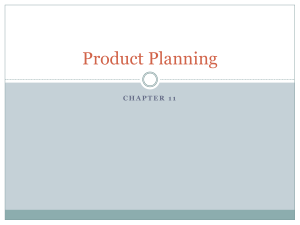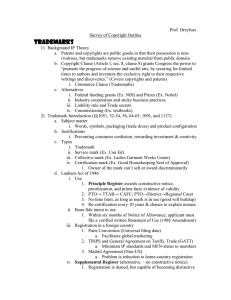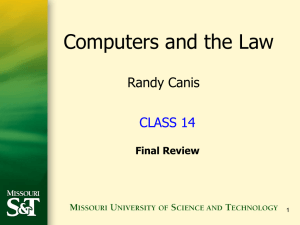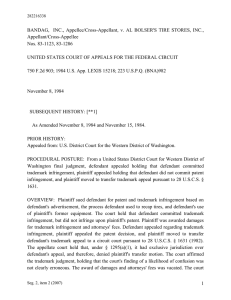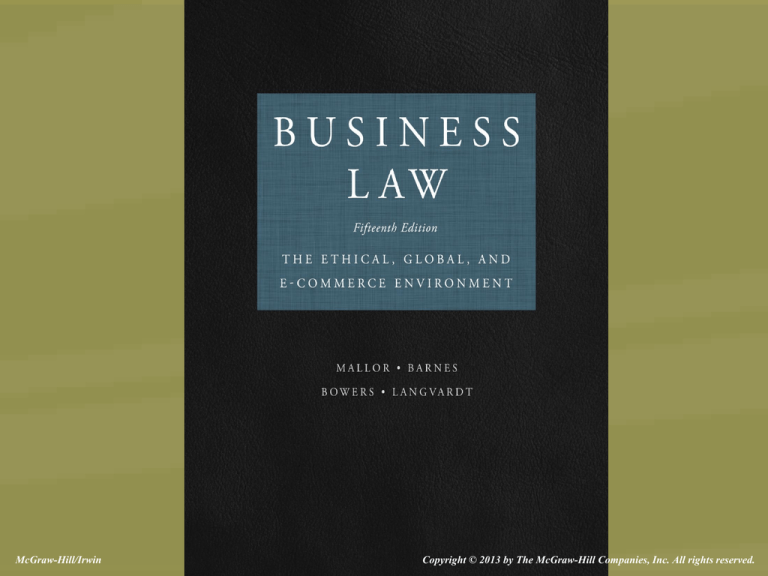
McGraw-Hill/Irwin
8-1
Copyright © 2013 by The McGraw-Hill Companies, Inc. All rights reserved.
P
A
R
T
Crimes and Torts
2
•Crimes
•Intentional Torts
•Negligence and Strict Liability
•Intellectual Property and Unfair
Competition
8-2
C H A P T E R
8
Intellectual Property and
Unfair Competition
I dream for a living.
Steven Spielberg
quoted in
Time magazine
July 1985
8-3
Learning Objectives
• Differentiate the various intellectual
property rights: patent, copyright,
and trademark
• Describe infringement and defenses
• Explain misappropriation theory and
the importance of trade secrets
• Identify the elements a plaintiff must
prove in unfair competition claims
8-4
Types of Intellectual Property
• PATENT:
– Engine design,
business
methods
• TRADEMARK
– Logo, trade
name
• COPYRIGHT
– Sales materials,
artwork
Marketing materials for Case
Construction Equipment
8-5
Patent
• Grant from federal government to an
inventor in which inventor obtains
exclusive right to make, use, and sell his
invention for a period of 20 years (14
years for designs)
• U.S. Patent Act requires registration
– http://www.uspto.gov/
8-6
Patent
• A patent will not be issued if more than
one year before patent application the
invention was patented elsewhere,
described in a printed publication, or in
public use or on sale in the United States
– Example: Pfaff v. Wells Electronics, Inc.
• Inventor sold patented item on April 8, 1981
• Inventor applied for patent on April 19, 1982
• More than one year passed, thus the patent
was invalid
8-7
Patent
• Protection for: a process, a machine, a
product or manufacture, a composition of
matter (such as a new chemical
compound), an improvement of any of the
above, an ornamental design for a product,
a plant produced by asexual reproduction,
certain business methods
• Even though an invention fits one of the
categories, it is not patentable if it lacks
novelty, is obvious, or has no utility
8-8
Patent Infringement
• Infringement occurs when defendant
makes, uses, or sells patented invention
without patentee’s authorization
• Remedy: monetary damages
– Global-Tech Appliances, Inc. v. SEB S.A.
• Infringement established by literal
infringement or doctrine of equivalents
– Whether alleged infringer’s subject matter
performs substantially same function as protected
invention in substantially same way for same result
8-9
Copyright
• Intangible right granted by statute to
the author or creator of certain tangible
literary or artistic productions
– Can’t copyright an “idea”
• Applicable law: Copyright Protection
Act and Copyright Term Extension Act
Visit the U.S. Copyright Office
8-10
Copyright
• Protection automatic; registration not
required, though recommended
• Works created after 1/78 are given
protection for life of author + 70 years
• Protection for a work-for-hire
(corporation owns copyright) is 95 years
from first publication or 120 years from
creation, whichever comes first
8-11
Work-for-Hire
• A work-for-hire exists when
– an employee, in the course of her regular
employment duties, creates a
copyrightable work; or
– an individual or corporation and an
independent contractor (nonemployee)
enter into a written “hire” agreement
under which the non-employee creates
a copyrightable work for the individual or
corporation
8-12
Infringement
• Violation of intellectual property right:
when someone uses, makes, or sells
another’s trademarked, patented, or
copyrighted intellectual property
without owner’s permission, license,
franchise
• Penalties -- actual or statutory
damages in civil proceedings or
criminal penalties for willful violations
8-13
Proof of Infringement
• Infringement generally requires proof that:
– defendant had access to protected work;
– defendant engaged in enough copying
(deliberately or subconsciously) that
resemblance between allegedly infringing
work and protected work could not be
coincidental; and
– substantial similarity exists between the
works
8-14
The “Fair Use” Defense
• A fair use defense or exception exists
when a copyrighted work or trademark
is used without the property holder’s
permission, but the use was:
– “For purposes such as criticism, comment,
news reporting, teaching (including multiple
copies for classroom use), scholarship, or
research” Section 107 of the Copyright Act
8-15
The “Fair Use” Defense
• A court weighs several factors in a fair
use determination:
– purpose and character of the use,
– nature of the copyrighted work,
– amount and substantiality of portion used
in relation to copyrighted work as a whole,
– effect of use on the potential markets for
the copyrighted work or on its value
8-16
Trademark
• Distinctive mark, motto, device, or
emblem that a manufacturer or
service provider stamps, prints, or
affixes to products it produces or
services it performs to distinguish
products or services from those of
competitors
• Applicable law: Lanham Act
• Registration with government
recommended, but not required
8-17
Trademark
• “Trademark” applicable to:
–
–
–
–
Trade name (e.g., McDonald’s, Nike)
Trade image (e.g., Ronald McDonald)
Trade logo (golden arches, swoosh)
Trade dress (orange & red of McDonald’s)
• Trademark dilution is the diminishment
of the capacity of plaintiff's marks to
identify and distinguish plaintiff's goods
or services
8-18
Trade Secrets
• Trade secret: any secret formula, pattern,
process, program, device, method,
technique, or database used in the
owner’s business that offers competitive
advantage
• A firm must take reasonable measures to
maintain secrecy
8-19
Misappropriation
• Misappropriation of a trade secret
occurs when a person discloses or uses
after acquiring the secret:
– By improper means (theft, trespass, etc.)
– Through another party who is known or
should have been known to have
obtained the secret by improper means,
– By breaching a duty of confidentiality
• See Coleman v. Retina Consultants, P.C.
8-20
Commercial Torts
• Commercial torts are intentional torts
that involve business or commercial
competition
• Injurious falsehood (product
disparagement) involves publishing
false statements that disparage
another’s business, property, or title to
property, harming economic interests
8-21
Commercial Torts
• Intentional interference with contractual
relations occurs when one party to a
contract claims that the defendant’s
interference with the other party’s
performance of the contract wrongly
caused the plaintiff to lose the benefit of
that performance
See the Lewis-Gale
Medical Center case
8-22
Commercial Torts
• Intentional interference with prospective
advantage parallels elements for
interference with contractual relations, but
prospective relations are focus (not existing
contracts)
• Section 43(a) of the Lanham Act creates civil
liability for unfair competition, including
misleading, confusing, or deceptive
representations made in connection with
goods or services
8-23
Thought Questions
• Music is intellectual
property. What do you
think about people
who download music
illegally? Have they
committed theft?
• If you create a new
product at your
workplace, is it yours?
8-24






